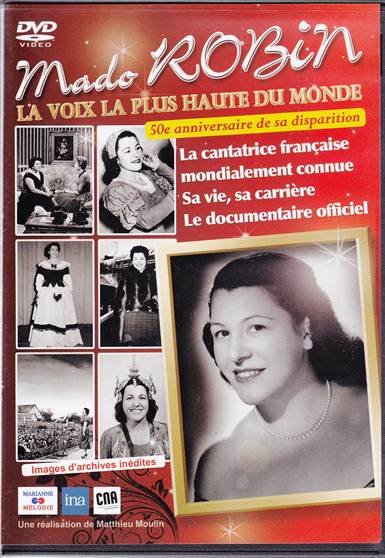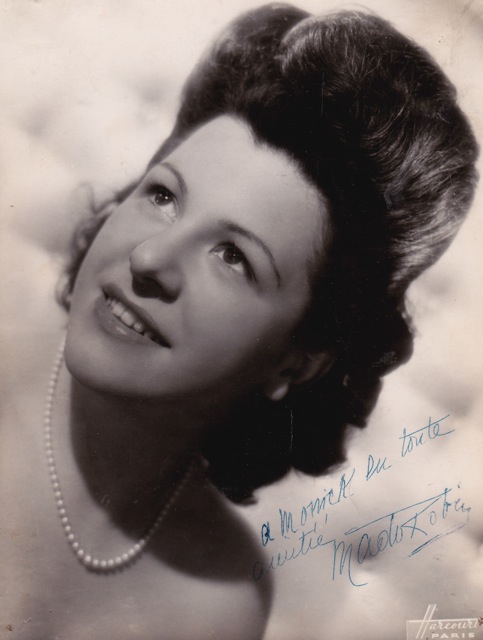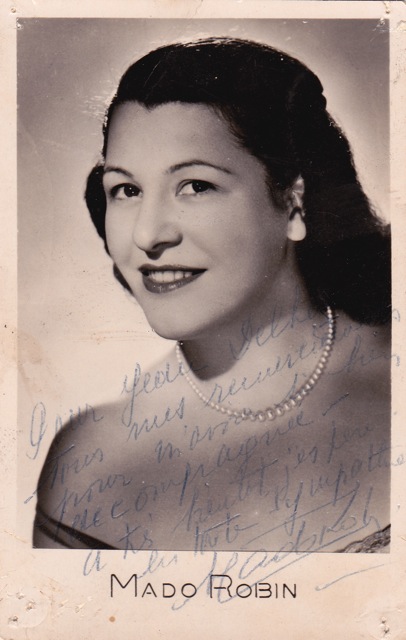

 (courtesy Charles Mintzer)
(courtesy Charles Mintzer)MADO ROBIN: La voix la plus haute du monde (DVD)


 (courtesy Charles Mintzer)
(courtesy Charles Mintzer)
Just listen to video number 15 on this DVD : Indian Love Call from Friml’s Rose-Marie. That is vintage Robin. She caresses a worn out melody, uses every possibility of shading, goes from full voice to a delicate piano and ennobles a song which often sounds vulgar in another singer’s voice. And to cap it all she doesn’t use her formidable almost freakish top notes.
Even more than those fabulous D’s above high D it are the sunny sound, the freshness and the girlishness of it all that convince the careful listener. Few years go by for me without playing her delightful “Mélodies de la belle époque”. Her predecessors and her successors sound stale compared to Robin in “Frou-Frou”, “Griserie”, “Fascination”, “Le temps des cerises” etc.
I vividly remember the announcer on Public Walloon Radio saying on that wintry day of 1960: “We have lost unexpectedly Mado Robin at age 42.” It is one of the legends surrounding the soprano that she quite late discovered her fatal disease. Her well known coach Simone Féjard (she must be 90 years old) and her colleague Michel Sénéchal clearly state that for quite some time she knew she had breast cancer; even that she very well knew she was condemned (says Sénéchal). Therefore it hurts the more to see Robin, friendly, charming and laughing as always, in a news broadcast at a moment she must have known the awful truth. Robin started well in life and lived quite a time in a real castle, owned by her great parents. In winter there was a spacious apartment in Paris. She married very young with Alan Smith, an Englishman who however had French nationality as well and then her life became almost a permanent tragedy. The couple had a daughter Michelle, a beautiful girl judging from old photo’s but mentally retarded. Shortly after the war her husband died in a car crash. At the end of her life Robin was obsessed with the fate of her daughter. As Simone Féjard says: “ we all thought she would die before her mother and look, she is still among us (we don’t get a view, maybe because she is extremely glutinous)”.
The DVD consists of a 2 hour 30 documentary and then throws in some extras. It is very well told by the sonorous voice of Stéphane Bern, a well-known presenter of historical productions at French television. Few of the artists who performed with Robin are still alive as the documentary was produced to commemorate the 50th anniversary of her death but lucky for us tenors Michel Sénéchal and Michel Cadiou (almost unknown outside France but a fine singer) can still give direct testimony. So does conductor Roberto Benzi who, contrary to the singers and the coach, has little of interest to communicate. As for the more personal details Robin’s niece (and guardian of daughter Michelle) is the appropriate source. As often in this kind of French productions one has to get a little used to French hyperbole as to the importance of the singer. We get the message that she was world famous though the number of theatres outside France is definitely not astonishing and none of them (with the exception of San Francisco) belonged to the top. For a documentary on a “world famous” woman, it is therefore somewhat strange that no titles are available in any language, not even in French. The documentary doesn’t start out well: the video fragment we see and hear is derived from a movie and the production team has fallen in the well known trap: the sound is sharp and Robin sounds even more chirpy necessary. But from that moment on it is smooth sailing. Even if one doesn’t understand a single word of French this DVD is a must as one gets 16 selections (yes, sixteen songs and arias. French television knew its duty in the fifties). This explains too the length of the documentary as the makers (bless them) didn’t resort to the usual tricks of giving us from ten to thirty seconds of music making before once again taking up the thread of life and career while the frustrated viewer wants the singer to continue. No, we get all the footage there exists on Robin and no aria is cut short. As a bonus there is the broadcast in its entirety – a Robin Special– from which some arias were culled.
Robin came late into the fray. The times of the small and high soprano voice were almost over after the war. During the twenties and thirties Toti Dal Monte in Italy, Erna Sack in Germany and Lily Pons in France could still have huge successes in some coloratura roles and start from there on a world career. During the fifties this became difficult as Callas succeeded in giving a whole new meaning to Robin’s favourite role: Lucia. Robin studied with Mario Podesta, friend and co-student at Fernando De Lucia’s lessons with Georges Thill. He succeeded in giving her an excellent Italian technique: the legato is outstanding, the coloratura is fine and yes there are the unbelievable high notes though at first Podesta was very careful. Only after several years Robin was allowed to sing a high D. Then she gradually discovered the voice upon the voice which indeed made her the highest female voice ever to sing a melodic line; contrary to some ladies like Sumac who could only hit some notes but not ascend and descend in a classic song or aria. As it became Robin’s trade mark she was always careful to interpolate some of those money notes in her performances and though we get no names there were some rows with conductors who detested her doing it though they well knew the public expected and loved it. During her Lucia performance in San Francisco in 1954 the management requested her not to sing her usual high D above high D in the “Il dolce suono” section of the madness scene for fear of offending Lily Pons who attended the performance. Mado Robin did not comply. People who heard her in that gigantic barn said the voice was more beautiful and carried better than the Pons sound (and personally Robin too was a far more likeable friendly and delicious being, notwithstanding all her tragedies) . Her French colleagues too tell us it was not a big sound, but it was crystal clear and projected well. We even get a picture of X-rays of the vocal folds of Robin and an explanation of her method to produce these notes. But as I said before, the Robin voice is not only a wonder of nature but it was handled with musicality, style, charm and it has lovely and immediately recognizable colours. It is not a white and rather impersonal voice like Natalie Dessay’s who never comes near Robin as a singer. The picture quality of this DVD is fine. Maybe it will come as a surprise that such lovely girlish sounds were made by a woman with a rather plain face and a somewhat Junoesque body (though not in the category of Tetrazzini and Pagliughi). I hope Marianne Melodie (www.marianne.melodie.fr) will produce further DVD’s of this kind. After all Alain Vanzo’s career too is very well preserved in the archives of French television and I hope the producing firm will act less provincial (the Editor bought this copy during a trip to Paris as the firm could not be persuaded to sell and send a copy to Flanders; a country at a two hours drive from Paris). Anyway, by hook or by crook, try to snatch up a copy of this wonderful DVD.
Jan Neckers